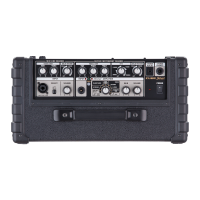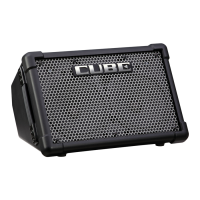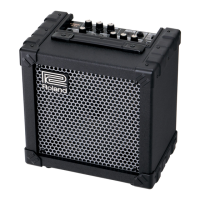26
Apr. 2014 CUBE-STEX
8. Set the AMPLIFIER type switch to MIC.
9. Connect the signal generator to the MIC/GUITAR INPUT jack
(unbalanced) and input the following signals.
1-kHz sine wave at -35.0 dBm
10. Verify that signals like the following are output from the speaker lines.
SP OUT L: +6.8 ±1.5 dBm
SP OUT R: +6.8 ±1.5 dBm
11. Set the AMPLIFIER type switch to CLEAN.
12. Input the following signals to the MIC/GUITAR INPU jack.
1-kHz sine wave at -20.0 dBm
13. Verify that signals like the following are output from the speaker lines.
SP OUT L: +15.3 ±1.5 dBm
SP OUT R: +15.3 ±1.5 dBm
14. Connect the signal generator to the AUX IN jack (monaural) and input the
following signals.
1-kHz sine wave at -3.0 dBm
15. Verify that signals like the following are output from the speaker lines.
SP OUT L: +15.1 ±1.5 dBm
SP OUT R: +15.1 ±1.5 dBm
16. Connect the i-CUBE LINK input/output tool to the i-CUBE LINK jack.
17. Connect the signal generator to the AUDIO IN L jack on the i-CUBE
LINK input/output tool and input the following signals.
1-kHz sine wave at -6.0 dBm
18. Verify that signals like the following are output from the speaker lines.
SP OUT L: +15.2 ±1.5 dBm
19. Connect the signal generator to the AUDIO IN R jack on the i-CUBE
LINK input/output tool and input the following signals.
1-kHz sine wave at -6.0 dBm
20. Verify that signals like the following are output from the speaker lines.
SP OUT R: +15.2 ±1.5 dBm
21. Connect the signal generator to the LINE IN L/MONO jack and input the
following signals.
1-kHz sine wave at -8.0 dBm
22. Verify that signals like the following are output from the speaker lines.
SP OUT L: +14.7 ±1.5 dBm
23. Connect the signal generator to the LINE IN R jack and input the
following signals.
1-kHz sine wave at -8.0 dBm
24. Verify that signals like the following are output from the speaker lines.
SP OUT R: +14.7 ±1.5 dBm
PHONES Verification
1. Connect the noise meter and the 1/4-inch stereo phone plug with 100 Ω
load resistor to the PHONES jack.
2. Connect the signal generator to the LINE IN L/MONO jack and input the
following signals.
1-kHz sine wave at -9.5 dBm
3. Verify that signals like the following are output from the PHONES jack
(L).
PHONES L: +2.5 ±1.5 dBm
4. Connect the signal generator to the LINE IN R jack and input the
following signals.
1-kHz sine wave at -9.5 dBm
5. Verify that signals like the following are output from the PHONES jack
(R).
PHONES R: +2.5 ±1.5 dBm
LINE OUT Verification
1. Connect the noise meter and the 1/4-inch phone plug with 47 kΩ load
resister to the LINE OUT L/MONO jack.
2. Connect the signal generator to the LINE IN L/MONO jack and input the
following signals.
1-kHz sine wave at +2.5 dBm
3. Verify that signals like the following are output from the LINE OUT L/
MONO jacks.
LINE OUT L/MONO: +8.0 ±1.5 dBm
4. Connect the 1/4-inch phone plug with 47 kΩ load resister to the LINE
OUT R jack.
5. Connect the signal generator to the LINE IN R jack and input the
following signals.
1-kHz sine wave at -2.5 dBm
6. Verify that signals like the following are output from the LINE OUT R
jack.
LINE OUT R: +8.0 ±1.5 dBm
i-CUBE LINK Verification
1. Connect the noise meter to the i-CUBE LINK OUT jack (with 1 kΩ load
resistor) on the i-CUBE LINK input/output tool.
2. Connect the signal generator to the LINE IN L/MONO jack and input the
following signals.
1-kHz sine wave at -19.0 dBm
3. Verify that signals like the following are output from the i-CUBE LINK
OUT jack on the i-CUBE LINK input/output tool.
i-CUBE LINK: -45.5 ±1.5 dBm

